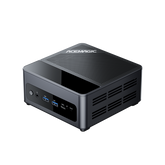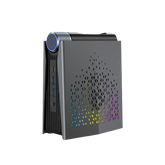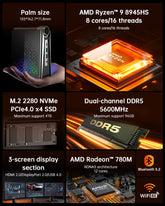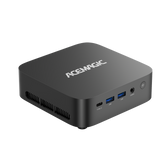Intel i7 vs i9: Performance and Value for Money Comparison (2025)

In Intel's Core series, ranging from the entry-level i3 to the mainstream i5 and high-end i7 and i9 processors, each CPU represents a different performance tier. As high-performance processors, both the i7 and i9 are the go-to choices for gamers, video editors, 3D modelers, and developers, as well as for users who demand high system responsiveness and multitasking capabilities. The latest data (from Intel and UserBenchmark) shows that while the i9 has slight advantages in multi-core performance, overclocking potential, and overall efficiency, the question remains whether its price provides a significant enough improvement in everyday use cases.
Thus, it is essential to compare the i7 and i9 processors in detail, analyzing their differences and strengths in real-world scenarios, to help users make the most appropriate choice based on their needs. This article will break down the performance, power consumption, and cost-effectiveness of both processors and explore whether it’s worth paying the higher price for the i9 in high-demand applications.
Performance Comparison
Let's dive into several core parameters to compare Intel's i7 and i9 processors, providing you with a clearer understanding of the key differences in performance.
Intel i9 vs i7: Core Count and Thread Count
For everyday use and medium to heavy workloads, the i7 typically comes with 8 to 12 cores, which are sufficient for most users’ multitasking needs. However, for tasks like video rendering, 3D modeling, and other highly multi-threaded professional applications, more cores and threads can significantly boost work efficiency. For instance, the latest models show that the Core i7-13700K features 16 cores and 24 threads, whereas the Core i9-14900K boasts 24 cores and 32 threads. This difference gives the i9 a clear advantage when handling intensive multi-tasking scenarios. The following table provides a direct comparison of core and thread counts for both products:
| Parameter | Core i9-14900K | Core i7-13700K |
|---|---|---|
| Cores | 24 | 16 |
| Threads | 32 | 24 |
More cores and threads mean that the i9 can complete parallel computing tasks faster, especially in video editing, large-scale compiling tasks, and virtualization applications, where the difference is particularly noticeable.
Intel i7 vs i9: Maximum Boost Frequency
In addition to core and thread count, boost frequency (Turbo Clock) is an important metric for assessing single-thread performance. Typically, the i9 line excels in this area as well. For example, the Core i9-14900K can reach a maximum boost frequency of 6.0GHz, while the Core i7-13700K tops out at around 5.4GHz. This increase in frequency provides a smoother experience in scenarios that require fast responses and high single-thread performance, such as gaming, certain office applications, and single-threaded tasks. Below is a brief comparison of the base and boost clock speeds of both processors:
| Parameter | Core i9-14900K | Core i7-13700K |
|---|---|---|
| Base Clock | 3.2 GHz | 3.4 GHz |
| Boost Clock | 6.0 GHz | 5.4 GHz |
While the i7 has a slight advantage in base frequency, the i9’s higher boost frequency excels in providing instant response times and handling high-load tasks, particularly when switching between tasks quickly or handling high-performance computing workloads.
Intel i7 vs i9: Cache Size
Cache size directly impacts a processor’s responsiveness when dealing with large data sets and complex computations. A larger cache helps reduce memory access latency, which in turn improves overall system performance. Generally, most i7 processors are equipped with around 33MB of Smart Cache, while i9 processors typically come with 36MB. While this difference might seem small, in high-demand scenarios, the additional cache can significantly enhance data processing efficiency, especially in multi-threaded tasks and large-scale computations, by alleviating memory bottlenecks.
In conclusion, the Intel i9 offers distinct advantages in terms of cores, threads, boost frequency, and cache size, making it better suited for users with intensive workloads or those requiring the best performance in multi-threaded and high-load applications. However, whether these advantages justify the higher price depends on the specific needs of the user.
Energy Efficiency and Cooling
In terms of energy efficiency and cooling, while the i9 processor leads in performance, this often translates to higher power consumption and heat output, particularly under full load. Therefore, choosing an appropriate cooling solution is crucial to fully utilize the i9’s capabilities. Although both the i9-14900K and the i7-13700K have a Thermal Design Power (TDP) rated at 125 watts, the i9’s greater core count, higher boost frequencies, and stronger overclocking potential can generate more heat in real-world applications, requiring a more efficient cooling system to maintain stable performance.
The table below clearly shows the comparison of TDP and cooling requirements between the two processors:
| Parameter | Core i9-14900K | Core i7-13700K |
|---|---|---|
| Thermal Design Power (TDP) | 125W | 125W |
| Heat Output under Load | Higher (requires stronger cooling) | Lower (milder cooling needs) |
Despite having the same TDP, the i9 releases more heat during full-core overclocking and high-load operations compared to the i7. This makes high-performance cooling systems, such as advanced liquid or air cooling, essential for desktop setups using the i9. For laptops or compact PCs, the i7’s more moderate heat output could make it a more balanced choice, offering sufficient performance while simplifying cooling system design and reducing overall system noise.
Performance Differences in Specific Scenarios
Gaming Performance
Both the Core i9-14900K and the Core i7-13700K excel in gaming, but the i9, with its higher core count and faster boost frequencies, typically offers a slight advantage in high-refresh rate, ultra-high-resolution, or more demanding gaming scenarios. According to UserBenchmark data, the i9 outperforms the i7 in both single-core and multi-core speeds, meaning it can provide a smoother experience in games that require strong single-thread performance, especially at higher frame rates and graphical settings.
| Parameter | Core i9-14900K | Core i7-13700K |
|---|---|---|
| Single-Core | 239 Pts | 221 Pts |
| Dual-Core | 475 Pts | 442 Pts |
| Quad-Core | 946 Pts | 883 Pts |
| Octa-Core | 1,811 Pts | 1,686 Pts |
However, in most 1080p or 1440p gaming scenarios, the i7 is already powerful enough to meet the demands of most gamers. Particularly for high-refresh-rate monitors, the i7 can deliver a smooth gaming experience without noticeable frame drops. Thus, while the i9 offers better performance for those seeking the ultimate gaming experience, the i7 is more than sufficient for the vast majority of gamers.
Content Creation and Professional Applications
For content creation, video editing, 3D modeling, and other professional tasks, the i9 is undoubtedly the superior choice. The i9’s additional cores and threads allow it to excel in multi-threaded tasks, such as video rendering, 3D modeling, and virtualization, where the i9 can offer a significant performance boost. For example, the i9-14900K features 24 cores and 32 threads, while the i7-13700K only has 16 cores and 24 threads, giving the i9 a clear advantage when running tasks that require heavy parallel computing. In video editing and rendering applications, the i9 can handle complex graphics and video files more efficiently, reducing processing times and improving productivity.
| Parameter | Core i9-14900K | Core i7-13700K |
|---|---|---|
| Cores | 24 | 16 |
| Threads | 32 | 24 |
| Boost Frequency | 6 GHz | 5.4 GHz |
With its higher core and thread count, the i9 provides a clear advantage in professional content creation and computationally intensive tasks. For those working in these fields, the i9 is the ideal choice for improving efficiency and reducing wait times.
Everyday Use and Light Workloads
For everyday tasks like office work, web browsing, streaming, and other light workloads, the i7 is more than capable. The i7-13700K performs nearly identically to the i9 in these scenarios, making the i9’s higher performance unnecessary for typical users. In real-world use, the i9’s multi-core advantages aren’t as apparent in these light workloads, while the i7 provides better energy efficiency and lower heat output, making it an excellent option for standard tasks.
Price Comparison and Value for Money
Price Difference Between i7 and i9
When it comes to pricing, the difference between the Core i9-14900K and the Core i7-13700K is significant. Based on the latest prices on Amazon, the Core i9-14900K is priced at around $433, while the Core i7-13700K costs about $367, making the i9 roughly $66 more expensive than the i7. While this price gap may seem modest in the high-end CPU market, for users on a tight budget, this additional cost is worth careful consideration.
The i9 offers higher core counts, better boost frequencies, and larger caches, all of which contribute to stronger performance. However, whether this performance boost justifies the extra expenditure depends on your individual needs. If you’re a gamer or primarily perform light tasks, you may find the i7 more than sufficient. On the other hand, for those involved in heavy computational tasks, video rendering, or 3D modeling, the extra cost of the i9 could be well worth it, as it can significantly reduce processing time and enhance productivity.
Value for Money
In terms of value for money, the Core i7-13700K is undoubtedly a highly competitive option. If your primary tasks are gaming or general computing, the i7 provides more than enough performance at a reasonable price. For instance, gaming usually relies on single-core performance, and the i7 excels in this area, meeting the needs of most gamers. Moreover, the i7 performs efficiently with lower power consumption and minimal cooling demands, making it a more economical choice.
However, if your workload involves tasks like video editing, 3D rendering, large-scale data processing, or virtualization—heavily parallelized tasks—the i9’s performance advantage becomes more evident. In these cases, the extra cost of the i9 is justified, as it greatly boosts productivity, particularly when handling multiple concurrent tasks. The i9’s additional cores and threads can dramatically reduce rendering times and improve workflow efficiency.
Conclusion and Recommendations
When to Choose i7
If you are an average gamer, casual content creator, or someone who primarily engages in everyday tasks, the Core i7 is an excellent choice. For these tasks, the i7’s performance is more than sufficient, whether it’s for smooth gameplay or light video editing and 3D modeling. With 8 to 16 cores and high clock speeds, it provides stable performance for most users. Additionally, the relatively lower price makes it an excellent value-for-money choice for those with a limited budget but who still want a high-performance processor.

The i7 is also ideal for users who don’t need to handle high-concurrency tasks. If your work involves office applications, web browsing, or occasional content creation, the i7’s performance will be more than adequate, allowing you to complete tasks without spending extra money on an i9.
When to Choose i9
If you are a professional content creator, 3D modeler, AI developer, or involved in work that requires high-concurrency computing, the Core i9 is the better choice. Especially in multi-tasking and high-load scenarios, the i9’s additional cores and higher frequencies will help you save time and boost productivity. The i9 excels in video rendering, complex 3D modeling, and other demanding applications, where its extra performance will be fully realized. For users who require top-tier performance, the i9 will allow you to handle intensive tasks with ease.

Moreover, if you are working in virtualization, multi-threaded programming, or require a system capable of handling more demanding applications in the coming years, the i9 is also an ideal option.
ACEMAGIC M2A Intel Core i7 or i9 Gaming Mini PC

- Process: Intel® Core™ i7-12700H Processor or Intel® Core™ i9-12900H Processor.
- Graphics: NVIDIA GeForce RTX 3060 (12GB GDDR6 memory) / RTX 3070 (16GB GDDR6 memory)
- Memory: 32GB DDR5 4800MT/s Dual channel
- Ports & Buttons: 2.5G RJ45 Gigabit Ethernet Port, USB3.2, USB4, HDMI 2.0, DP 1.4
Selection Tips
When making your decision, the most crucial factors to consider are your budget and specific needs. If your budget is limited and your tasks are mainly general applications, the i7 is definitely the more cost-effective choice. It provides ample performance for most use cases without unnecessary extra costs.
However, if you have the budget and need top-tier performance—especially for heavy workloads or better multitasking capabilities—the i9 will offer you a more powerful processing experience. It will particularly shine in video editing, 3D modeling, and other professional applications, significantly boosting your work efficiency and processing speed.
In conclusion, both the i7 and i9 have their pros and cons. Your choice will depend on your specific requirements and budget. For everyday use and gaming, the i7 is more than adequate, while for demanding professional tasks requiring immense computational power, the i9 is the ideal choice.
References
Intel® Core™ i7 Prozessor – Funktionen, Vorteile und FAQs [Cited 2025 February 27] Available at: Link
Intel® Core™ i9 Processor - Features, Benefits and FAQs [Cited 2025 February 27] Available at: Link










